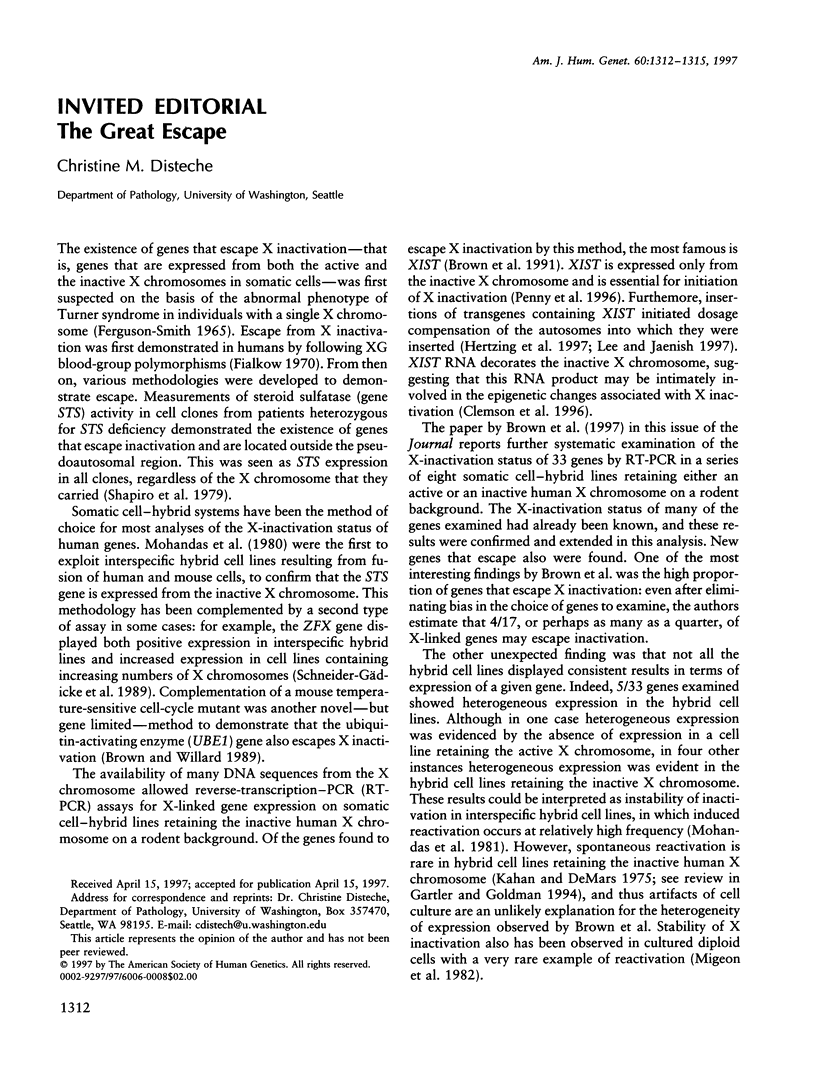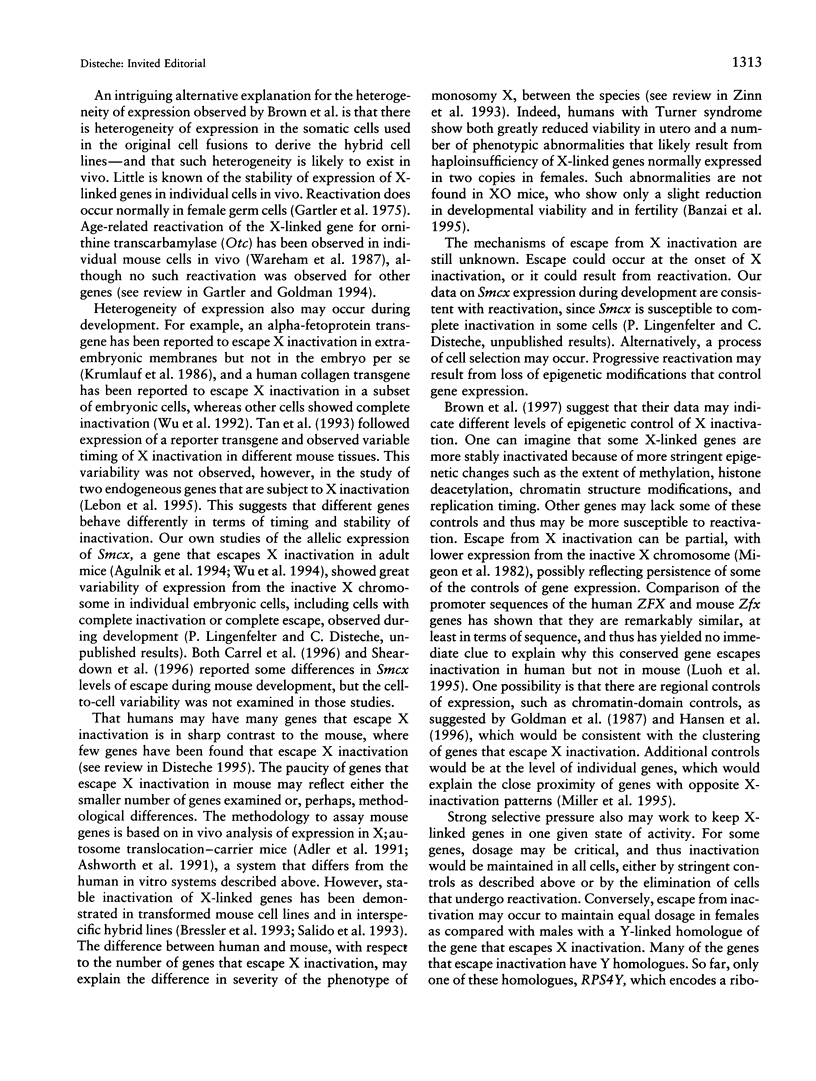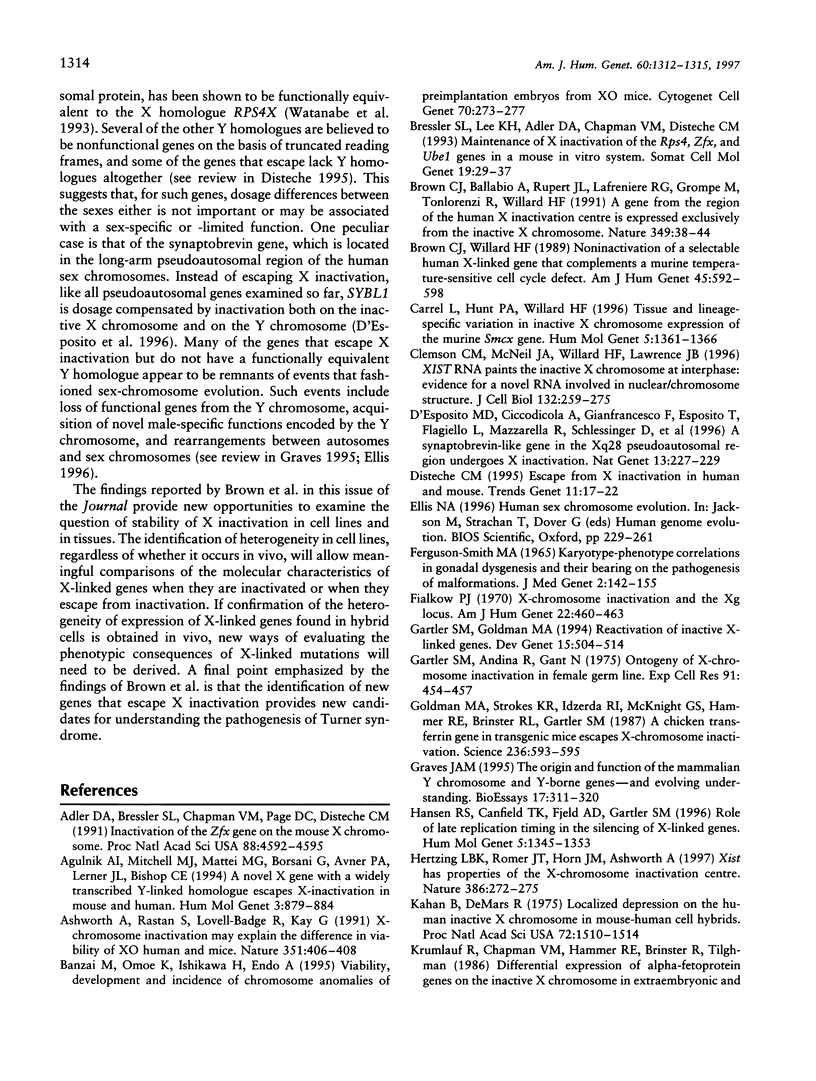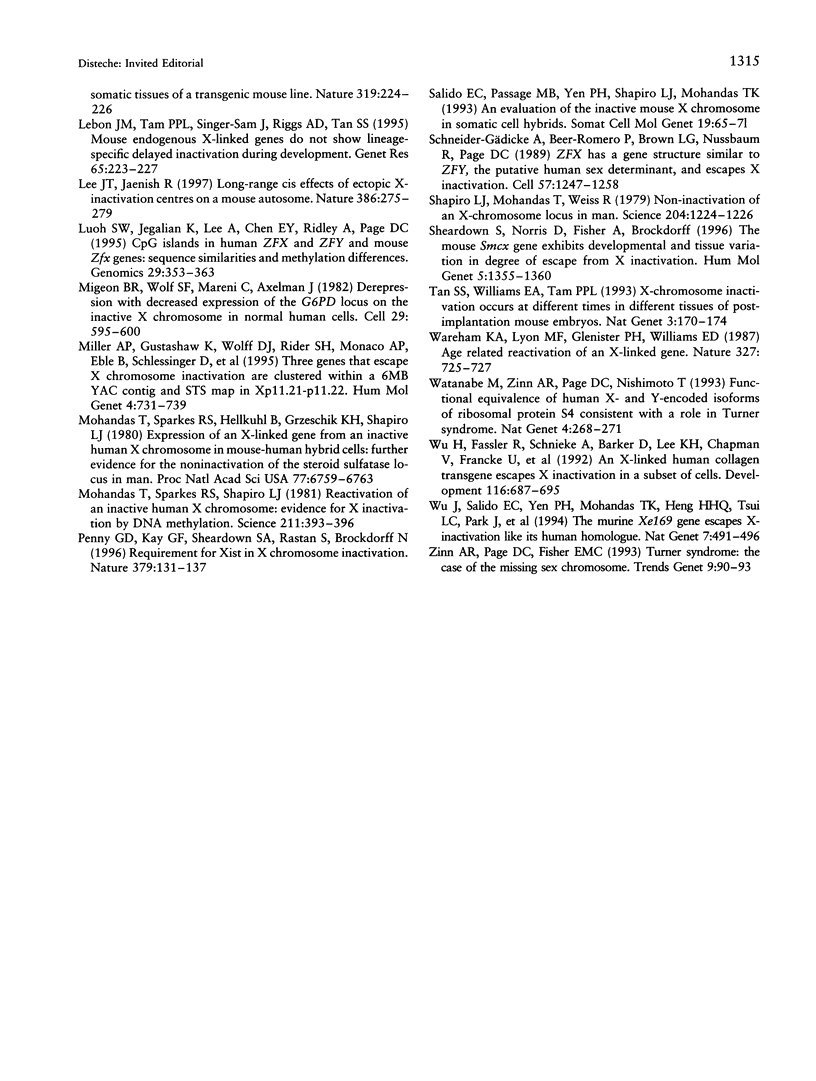Full text
PDF



Selected References
These references are in PubMed. This may not be the complete list of references from this article.
- Adler D. A., Bressler S. L., Chapman V. M., Page D. C., Disteche C. M. Inactivation of the Zfx gene on the mouse X chromosome. Proc Natl Acad Sci U S A. 1991 Jun 1;88(11):4592–4595. doi: 10.1073/pnas.88.11.4592. [DOI] [PMC free article] [PubMed] [Google Scholar]
- Agulnik A. I., Mitchell M. J., Mattei M. G., Borsani G., Avner P. A., Lerner J. L., Bishop C. E. A novel X gene with a widely transcribed Y-linked homologue escapes X-inactivation in mouse and human. Hum Mol Genet. 1994 Jun;3(6):879–884. doi: 10.1093/hmg/3.6.879. [DOI] [PubMed] [Google Scholar]
- Ashworth A., Rastan S., Lovell-Badge R., Kay G. X-chromosome inactivation may explain the difference in viability of XO humans and mice. Nature. 1991 May 30;351(6325):406–408. doi: 10.1038/351406a0. [DOI] [PubMed] [Google Scholar]
- Banzai M., Omoe K., Ishikawa H., Endo A. Viability, development and incidence of chromosome anomalies of preimplantation embryos from XO mice. Cytogenet Cell Genet. 1995;70(3-4):273–277. doi: 10.1159/000134050. [DOI] [PubMed] [Google Scholar]
- Bressler S. L., Lee K. H., Adler D. A., Chapman V. M., Disteche C. M. Maintenance of X inactivation of the Rps4, Zfx, and Ube1 genes in a mouse in vitro system. Somat Cell Mol Genet. 1993 Jan;19(1):29–37. doi: 10.1007/BF01233952. [DOI] [PubMed] [Google Scholar]
- Brown C. J., Ballabio A., Rupert J. L., Lafreniere R. G., Grompe M., Tonlorenzi R., Willard H. F. A gene from the region of the human X inactivation centre is expressed exclusively from the inactive X chromosome. Nature. 1991 Jan 3;349(6304):38–44. doi: 10.1038/349038a0. [DOI] [PubMed] [Google Scholar]
- Brown C. J., Willard H. F. Noninactivation of a selectable human X-linked gene that complements a murine temperature-sensitive cell cycle defect. Am J Hum Genet. 1989 Oct;45(4):592–598. [PMC free article] [PubMed] [Google Scholar]
- Carrel L., Hunt P. A., Willard H. F. Tissue and lineage-specific variation in inactive X chromosome expression of the murine Smcx gene. Hum Mol Genet. 1996 Sep;5(9):1361–1366. doi: 10.1093/hmg/5.9.1361. [DOI] [PubMed] [Google Scholar]
- Clemson C. M., McNeil J. A., Willard H. F., Lawrence J. B. XIST RNA paints the inactive X chromosome at interphase: evidence for a novel RNA involved in nuclear/chromosome structure. J Cell Biol. 1996 Feb;132(3):259–275. doi: 10.1083/jcb.132.3.259. [DOI] [PMC free article] [PubMed] [Google Scholar]
- D'Esposito M., Ciccodicola A., Gianfrancesco F., Esposito T., Flagiello L., Mazzarella R., Schlessinger D., D'Urso M. A synaptobrevin-like gene in the Xq28 pseudoautosomal region undergoes X inactivation. Nat Genet. 1996 Jun;13(2):227–229. doi: 10.1038/ng0696-227. [DOI] [PubMed] [Google Scholar]
- Disteche C. M. Escape from X inactivation in human and mouse. Trends Genet. 1995 Jan;11(1):17–22. doi: 10.1016/s0168-9525(00)88981-7. [DOI] [PubMed] [Google Scholar]
- FERGUSON-SMITH M. A. KARYOTYPE-PHENOTYPE CORRELATIONS IN GONADAL DYSGENESIS AND THEIR BEARING ON THE PATHOGENESIS OF MALFORMATIONS. J Med Genet. 1965 Jun;2(2):142–155. doi: 10.1136/jmg.2.2.142. [DOI] [PMC free article] [PubMed] [Google Scholar]
- Fialkow P. J. X-chromosome inactivation and the Xg locus. Am J Hum Genet. 1970 Jul;22(4):460–463. [PMC free article] [PubMed] [Google Scholar]
- Gartler S. M., Andina R., Gant N. Ontogeny of X-chromosome inactivation in the female germ line. Exp Cell Res. 1975 Mar 15;91(2):454–457. doi: 10.1016/0014-4827(75)90127-5. [DOI] [PubMed] [Google Scholar]
- Gartler S. M., Goldman M. A. Reactivation of inactive X-linked genes. Dev Genet. 1994;15(6):504–514. doi: 10.1002/dvg.1020150609. [DOI] [PubMed] [Google Scholar]
- Goldman M. A., Stokes K. R., Idzerda R. L., McKnight G. S., Hammer R. E., Brinster R. L., Gartler S. M. A chicken transferrin gene in transgenic mice escapes X-chromosome inactivation. Science. 1987 May 1;236(4801):593–595. doi: 10.1126/science.2437652. [DOI] [PubMed] [Google Scholar]
- Graves J. A. The origin and function of the mammalian Y chromosome and Y-borne genes--an evolving understanding. Bioessays. 1995 Apr;17(4):311–320. doi: 10.1002/bies.950170407. [DOI] [PubMed] [Google Scholar]
- Hansen R. S., Canfield T. K., Fjeld A. D., Gartler S. M. Role of late replication timing in the silencing of X-linked genes. Hum Mol Genet. 1996 Sep;5(9):1345–1353. doi: 10.1093/hmg/5.9.1345. [DOI] [PubMed] [Google Scholar]
- Herzing L. B., Romer J. T., Horn J. M., Ashworth A. Xist has properties of the X-chromosome inactivation centre. Nature. 1997 Mar 20;386(6622):272–275. doi: 10.1038/386272a0. [DOI] [PubMed] [Google Scholar]
- Kahan B., DeMars R. Localized Derepression on the Human Inactive X Chromosone in Mouse-Human Cell Hybrids. Proc Natl Acad Sci U S A. 1975 Apr;72(4):1510–1514. doi: 10.1073/pnas.72.4.1510. [DOI] [PMC free article] [PubMed] [Google Scholar]
- Lebon J. M., Tam P. P., Singer-Sam J., Riggs A. D., Tan S. S. Mouse endogenous X-linked genes do not show lineage-specific delayed inactivation during development. Genet Res. 1995 Jun;65(3):223–227. doi: 10.1017/s0016672300033292. [DOI] [PubMed] [Google Scholar]
- Lee J. T., Jaenisch R. Long-range cis effects of ectopic X-inactivation centres on a mouse autosome. Nature. 1997 Mar 20;386(6622):275–279. doi: 10.1038/386275a0. [DOI] [PubMed] [Google Scholar]
- Luoh S. W., Jegalian K., Lee A., Chen E. Y., Ridley A., Page D. C. CpG islands in human ZFX and ZFY and mouse Zfx genes: sequence similarities and methylation differences. Genomics. 1995 Sep 20;29(2):353–363. doi: 10.1006/geno.1995.9994. [DOI] [PubMed] [Google Scholar]
- Migeon B. R., Wolf S. F., Mareni C., Axelman J. Derepression with decreased expression of the G6PD locus on the inactive X chromosome in normal human cells. Cell. 1982 Jun;29(2):595–600. doi: 10.1016/0092-8674(82)90175-1. [DOI] [PubMed] [Google Scholar]
- Miller A. P., Gustashaw K., Wolff D. J., Rider S. H., Monaco A. P., Eble B., Schlessinger D., Gorski J. L., van Ommen G. J., Weissenbach J. Three genes that escape X chromosome inactivation are clustered within a 6 Mb YAC contig and STS map in Xp11.21-p11.22. Hum Mol Genet. 1995 Apr;4(4):731–739. doi: 10.1093/hmg/4.4.731. [DOI] [PubMed] [Google Scholar]
- Mohandas T., Sparkes R. S., Hellkuhl B., Grzeschik K. H., Shapiro L. J. Expression of an X-linked gene from an inactive human X chromosome in mouse-human hybrid cells: further evidence for the noninactivation of the steroid sulfatase locus in man. Proc Natl Acad Sci U S A. 1980 Nov;77(11):6759–6763. doi: 10.1073/pnas.77.11.6759. [DOI] [PMC free article] [PubMed] [Google Scholar]
- Mohandas T., Sparkes R. S., Shapiro L. J. Reactivation of an inactive human X chromosome: evidence for X inactivation by DNA methylation. Science. 1981 Jan 23;211(4480):393–396. doi: 10.1126/science.6164095. [DOI] [PubMed] [Google Scholar]
- Penny G. D., Kay G. F., Sheardown S. A., Rastan S., Brockdorff N. Requirement for Xist in X chromosome inactivation. Nature. 1996 Jan 11;379(6561):131–137. doi: 10.1038/379131a0. [DOI] [PubMed] [Google Scholar]
- Salido E. C., Passage M. B., Yen P. H., Shapiro L. J., Mohandas T. K. An evaluation of the inactive mouse X chromosome in somatic cell hybrids. Somat Cell Mol Genet. 1993 Jan;19(1):65–71. doi: 10.1007/BF01233955. [DOI] [PubMed] [Google Scholar]
- Schneider-Gädicke A., Beer-Romero P., Brown L. G., Nussbaum R., Page D. C. ZFX has a gene structure similar to ZFY, the putative human sex determinant, and escapes X inactivation. Cell. 1989 Jun 30;57(7):1247–1258. doi: 10.1016/0092-8674(89)90061-5. [DOI] [PubMed] [Google Scholar]
- Shapiro L. J., Mohandas T., Weiss R., Romeo G. Non-inactivation of an x-chromosome locus in man. Science. 1979 Jun 15;204(4398):1224–1226. doi: 10.1126/science.156396. [DOI] [PubMed] [Google Scholar]
- Sheardown S., Norris D., Fisher A., Brockdorff N. The mouse Smcx gene exhibits developmental and tissue specific variation in degree of escape from X inactivation. Hum Mol Genet. 1996 Sep;5(9):1355–1360. doi: 10.1093/hmg/5.9.1355. [DOI] [PubMed] [Google Scholar]
- Tan S. S., Williams E. A., Tam P. P. X-chromosome inactivation occurs at different times in different tissues of the post-implantation mouse embryo. Nat Genet. 1993 Feb;3(2):170–174. doi: 10.1038/ng0293-170. [DOI] [PubMed] [Google Scholar]
- Wareham K. A., Lyon M. F., Glenister P. H., Williams E. D. Age related reactivation of an X-linked gene. 1987 Jun 25-Jul 1Nature. 327(6124):725–727. doi: 10.1038/327725a0. [DOI] [PubMed] [Google Scholar]
- Watanabe M., Zinn A. R., Page D. C., Nishimoto T. Functional equivalence of human X- and Y-encoded isoforms of ribosomal protein S4 consistent with a role in Turner syndrome. Nat Genet. 1993 Jul;4(3):268–271. doi: 10.1038/ng0793-268. [DOI] [PubMed] [Google Scholar]
- Wu H., Fässler R., Schnieke A., Barker D., Lee K. H., Chapman V., Francke U., Jaenisch R. An X-linked human collagen transgene escapes X inactivation in a subset of cells. Development. 1992 Nov;116(3):687–695. doi: 10.1242/dev.116.3.687. [DOI] [PubMed] [Google Scholar]
- Wu J., Salido E. C., Yen P. H., Mohandas T. K., Heng H. H., Tsui L. C., Park J., Chapman V. M., Shapiro L. J. The murine Xe169 gene escapes X-inactivation like its human homologue. Nat Genet. 1994 Aug;7(4):491–496. doi: 10.1038/ng0894-491. [DOI] [PubMed] [Google Scholar]
- Zinn A. R., Page D. C., Fisher E. M. Turner syndrome: the case of the missing sex chromosome. Trends Genet. 1993 Mar;9(3):90–93. doi: 10.1016/0168-9525(93)90230-f. [DOI] [PubMed] [Google Scholar]


